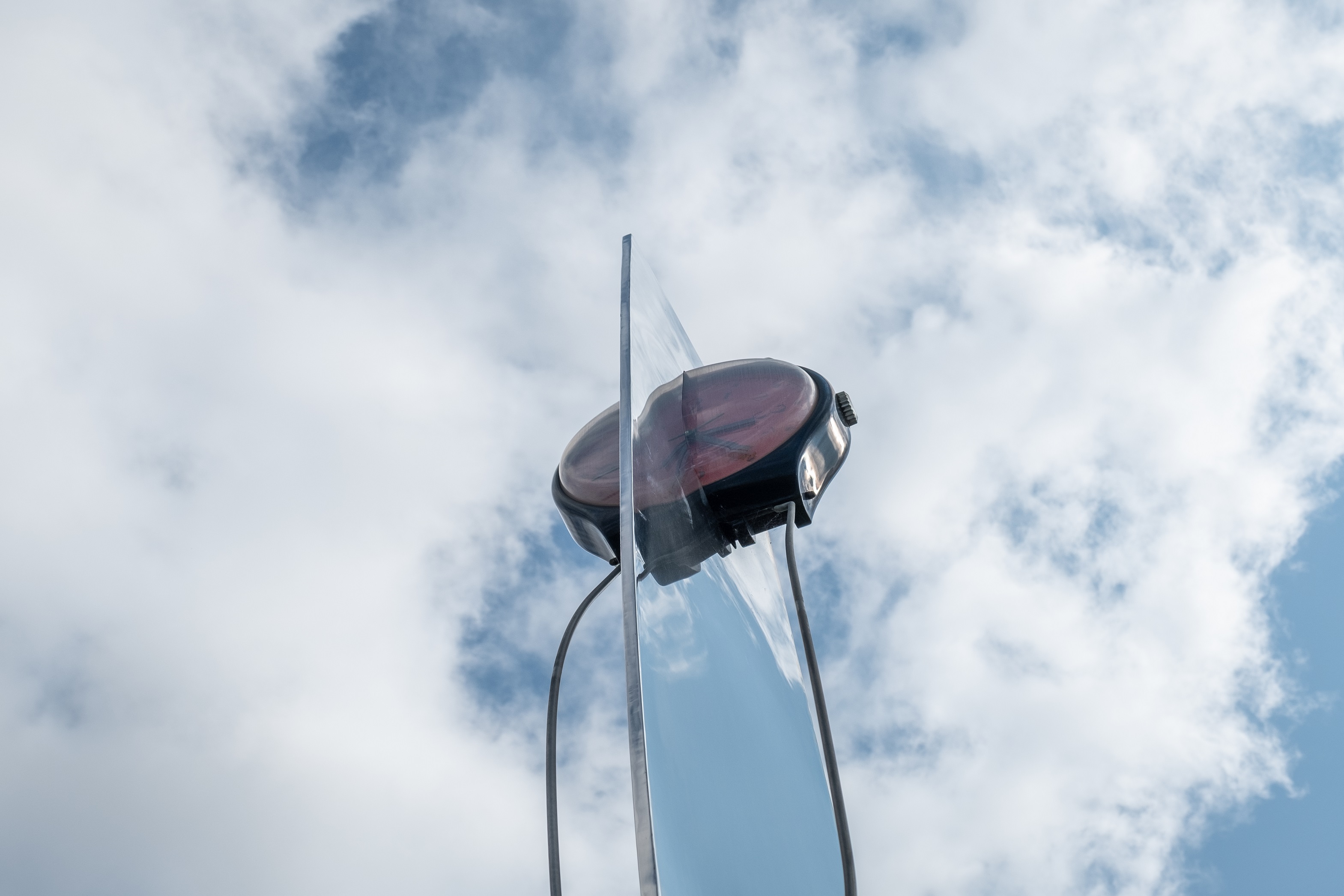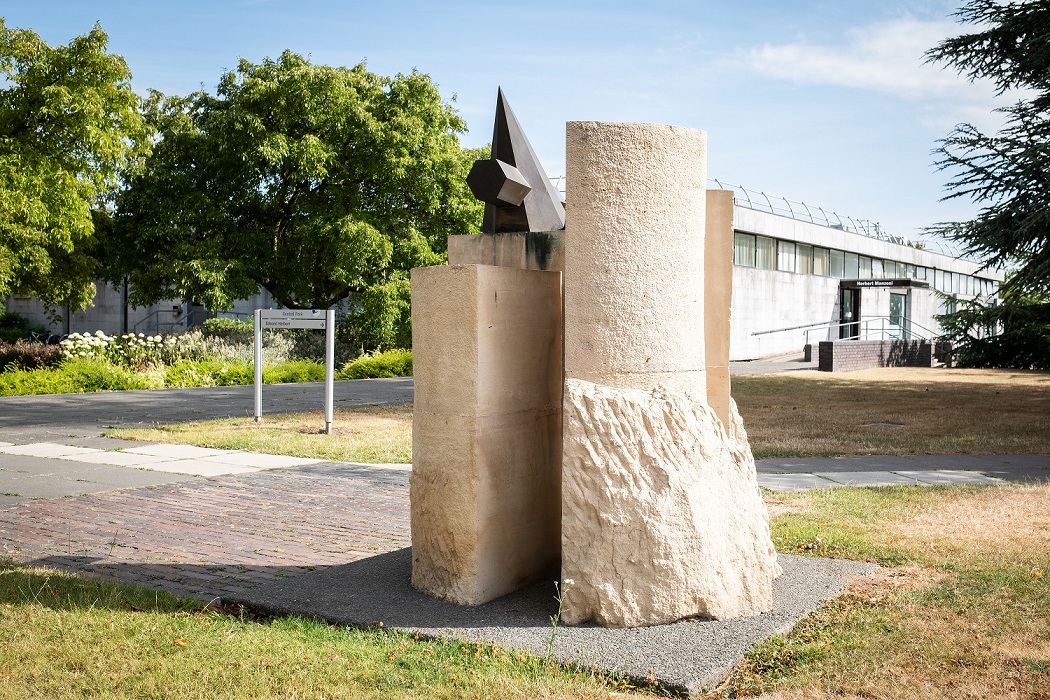Sculpture
Our campus has over forty sculptures across its 523 acres dating from the 1950s to the present day. The collection includes works by Atta Kwami, Lynn Chadwick, Bernard Schottlander and Margaret Traherne.
There are sculptures in stone, steel, aluminium, bronze, concrete and one made partly from mycelium - the root-like strcuture of fungus! Everyone is welcome to visit our campus and explore the collection. Sculptures can be located using the Google Maps Sculpture Trail linked to below. This also includes a suggested step-free walking route, which cuts through the heart of the campus to take in many of our most interesting works. It's around 3km long, and has bus stops at either end.

Sculpture Leaflet
In March 2023 we launched a brand new printed sculpture leaflet which gives an introduction to our sculpture collection and useful information on visiting campus to see these artworks in person. The leaflet includes a fold out illustration of campus and selected sculptures designed by former student Lauren Jefferis. Lauren's illustrations were originally commissioned as part of the Edward Sharp Prize in 2020.
Information on individual works from our sculpture collection can be found below.
Ron Arad - UK Swatch Olympic Art Clock
Steel with plastic 'watch' face, 1996 (installed 1997)
Location (google maps)
This stainless steel sculpture and clock was commissioned by the watch manufacturers Swatch to celebrate the 1996 Atlanta Olympics. Prior to the Olympics it was installed outside London's Royal Festival Hall, and there were plans to exhibit it in Atlanta for the duration of the Games along with sculptural clocks by eleven other artists and designers from around the world, though this proposal fell through. Following the games, Swatch donated the sculpture to the University in recognition of its sporting prowess.
Ron Arad is a British-Israeli industrial designer, artist and architectural designer. He has designed for companies including Swarovski, Adidas, Fiat, Samsung, Bombay Sapphire and Le Coq Sportif. Solo exhibitions of his artistic work have been held at Centre Pompidou, Paris; MoMA, New York and the Barbican, London; and he has been involved in the design of public and commercial buildings across the world.
Michael Dan Archer - Per Saeculi Quartum
Bronze and Cadeby limestone, 1991
Location (google maps)
Per Saeculi Quartum ('Through a Quarter of a Century') was commissioned by the University in 1991 to celebrate the 25th anniversary of the granting of a Royal Charter, which transformed Loughborough College of Technology into Loughborough University of Technology (the ‘of Technology’ was dropped in 1996). The winning entry from an open competition, Archer described the fractured circular stone base as representing a hundred years. The bronze sits on the second segment to symbolise the then forthcoming quarter of a century, ‘with all the intentions and possibilities for the future implicit in this.’
Archer taught at Loughborough College of Art and Design, which was amalgamated into the University in 1998; and along with colleagues including John Atkin and Paul Wager was part of ‘The Loughborough Group’ of sculptors. He retired from the University in 2019. Other notable commissions include the Ouseburn Lock Gates in Newcastle-upon-Tyne; and sculptures in London, Cardiff and Cambridge.
Per Saeculi Quartum replaced a previous work on this site: Man and Child by Ralph Brown, which was vandalized beyond repair in the 1980s.
The sculpture's stone elements were cleaned using a superheated water in early 2020. The bronze element was conserved by Lowri Davies of 3D Conservation in the summer of 2022 with the aid of a grant from the Henry Moore Foundation.
Michael Dan Archer - Skellig
Kirkstone green slate, bronze and salt, 2001
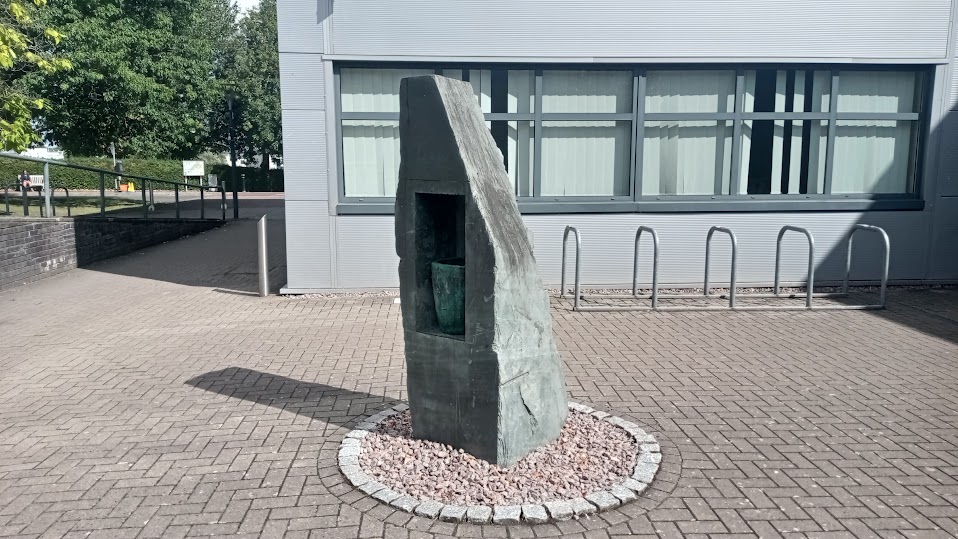
Location (google maps)
Installed in 2001 to mark the opening of the Stewart Mason Building, Skellig takes its name from two small rocky islands off the west coast of Ireland, home to an early Christian Monastery. It consists of a striking hunk of Kirkstone Green Slate from the Lake District in which sits a bronze crucible. This latter element was cast from a crucible used in the University's sculpture workshop in 2001. Archer was interested in it as a site in which base material (bronze) was turned into art (sculpture), and sought to incorporate this process into the sculpture by the addition of salt in the bottom of the crucible. Periodically topped-up, this interacts with the atmospheric conditions to produce a constantly changing patina on the bronze. Together, the sculpture's form and materials are thus suggestive of multiple transformations: geologic, artistic, atmospheric, religious, taking place over different timescales.
The work was installed during Archer's time as a Lecturer in Sculpture at the University.
A further work by Archer can be found in the courtyard garden of Burleigh Court Hotel. This was initially produced for a Jill Billington show garden at Chelsea Flower Show in 1991. Ordinarily, this sculpture is only accessible to hotel guests.
Chiara Brown, Fred Hendry Briars and Andrea Pocock - Flux
Burned and oiled Larch Wood, 2023
Generously funded by Barry and Valerie Eccleston
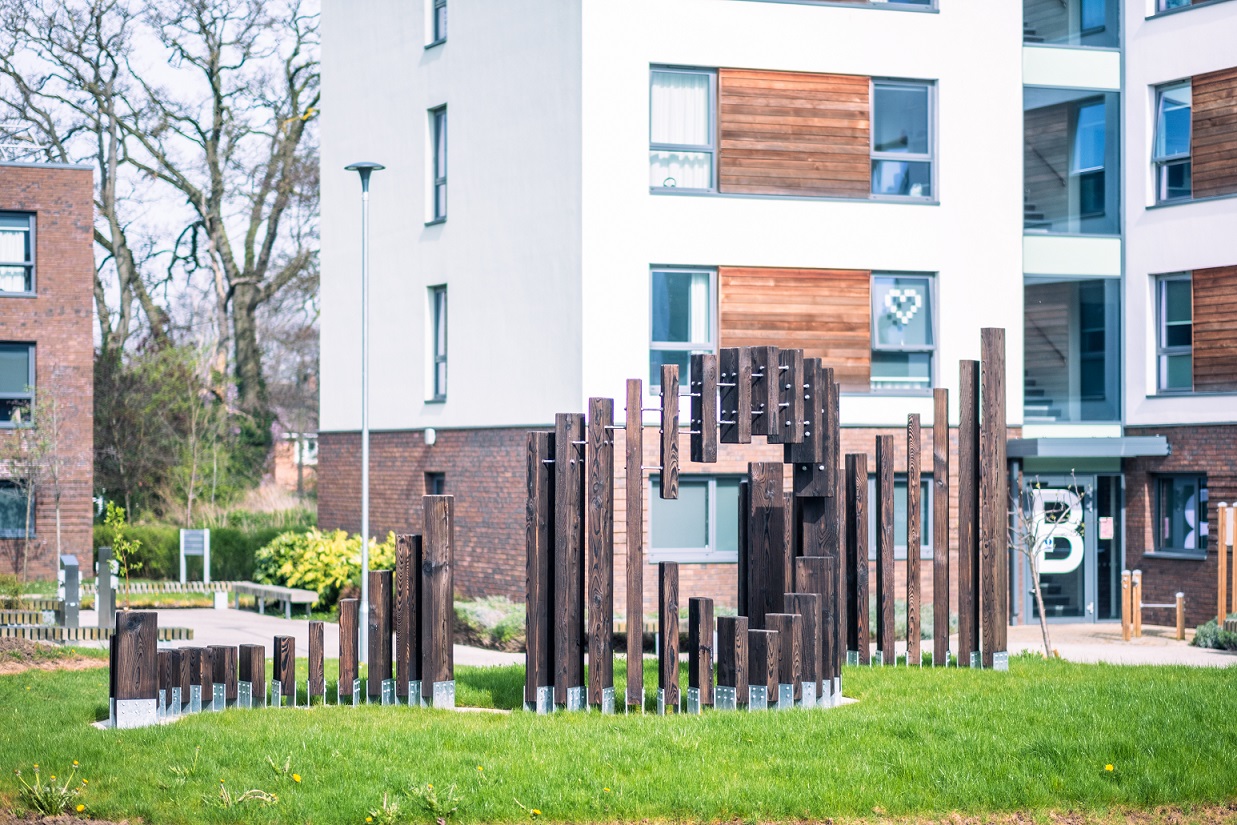
Location (google maps)
Flux is one of the most ambitious student artworks realized on the campus of a British university in recent years. Produced by an inter-disciplinary team of undergraduate students, it utilizes aesthetics and techniques from architecture, engineering, and contemporary art. It makes clever use of both positive and negative space, with considerable thought given to how its shadow impacts the surrounding area. It has been produced using timber from a sustainable forest in Wales, with its dark colour resulting from a burning process inspired by the Japanese wood preservation technique yakisugi.
Conceptually, the sculpture references two journeys: its undulating shape is inspired by the highs and lows of the ‘student journey’, while the circular cut-out references Loughborough graduate Claudia Parson’s circumnavigation of the world by car (the first by a woman). Yet it is also designed to encourage passers-by to pause and reflect; taking time out of their day to consider the work from different angles, perch on its lower elements, or use the work to frame the environment.
Each of Flux’s creators studied at Loughborough University. Chiara Brown graduated with a Master’s in Civil Engineering in 2022, and at the time of the work’s completion was applying her expertise in sustainability, innovation and bridge design as a bridge engineer. Fred Hendry Briars graduated as a Bachelor of Architecture in 2022 before continuing his studies with a Master’s in Architecture at Iceland University of the Arts, where he developed conceptual projects responding to the Icelandic landscape. Andrea Pocock graduated with a Bachelor’s Degree in Fine Art in 2021 and was running Cloudscape Studio, producing bespoke lighting creations while working as a Programme Administrator in the School of Design and Creative Arts.
The artists were provided with mentoring support from Ivan Morison, who has produced numerous commissions—many in collaboration with Heather Peak—that work across (and beyond) art, architecture, theatre and activism.
Donald Brook - The Wall
Fibreglass reinforced concrete, 1961
.jpg)
Location (google maps)
An imposing modernist work, The Wall is stylistically reminiscent of the friezes found on many public buildings of its era, though its free-standing form is unusual. It was commissioned to complement the new halls of residence built for Loughborough College of Advanced Technology in the early 1960s: the mechanical tools moulded into it are no doubt a reference to the subjects taught at the College, a forerunner to today’s University. There is some evidence that the sculpture was had a cream coating.
Donald Brook was born in Leeds in 1927 and produced a number of sculptural works in the 1950s and 60s, of which The Wall is believed to be the last remaining example. In the late 60s he moved to Australia, where he was appointed as one of the inaugural academics in the Power Institute of Fine Art at the University of Sydney. Well-known as a theorist and critic of art, he was integral to early debates about conceptual art, and continued to publish on the meaning and nature of art well into his late eighties. He died in 2018.
The Wall is one of many artworks in the University’s collection commissioned or purchased under the auspices of Stewart Mason, who was Leicestershire's Director of Education from 1947-71. He strongly believed that educational environments should be populated with challenging works of contemporary art, and worked with a team of advisors and contemporary art galleries to select works.
The Wall was the subject of substantive restoration work by Lowri Davies of 3D Conservation in the summer of 2022. We are grateful to the Henry Moore Foundation, whose grant helped to fund this work.
Emlyn Budds - Truth, Labour and Knowledge
Ancaster stone and bronze, 1999
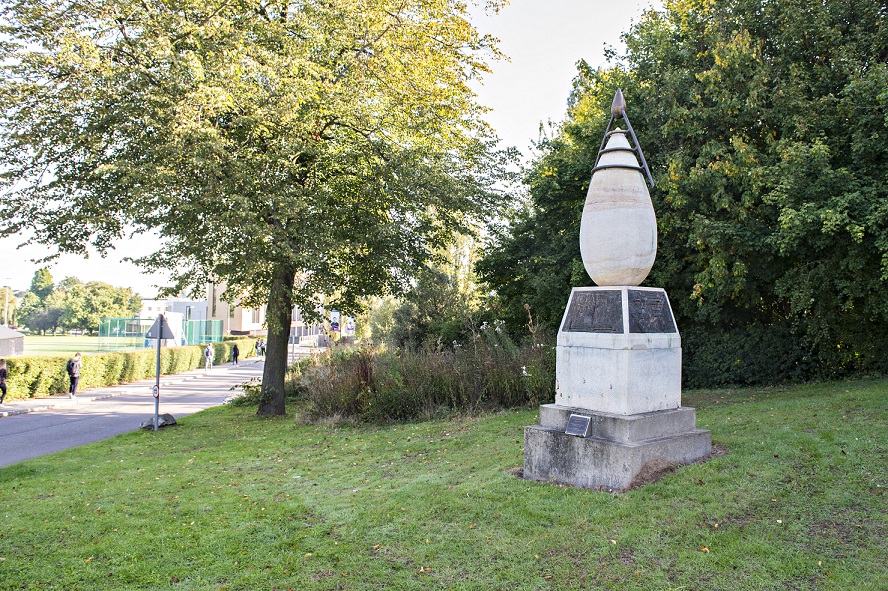
Location (google maps)
This grandly titled work (often referred to as 'The Easter Egg') was selected from a student competition to commemorate the integration of Loughborough College of Art and Design into the University. The 22-year old Budds was a student at the College and produced a design celebrating various forms of learning associated with the history of the University: engineering, electrics and science all feature in the bronze reliefs, echoing those on the nearby Brockington Building by Willi Soukop. The work was funded by the College's Past Students' Charitable Trust.
Budds went on to study Sculpture at the Royal College of Art and the Henry Moore Institute. After periods making furniture and film props (including for Ridley Scott's Robin Hood), as of 2022 he lives in his native Norwich where he produces carved oak memorials.
Lynn Chadwick - The Watchers
Bronze, 1960 (installed 1966)
.jpg)
Location (google maps)
The Watchers is a key work by Lynn Chadwick, one of Britain’s pre-eminent twentieth century sculptors. It was purchased for Loughborough College of Advanced Technology in 1966 and bar a loan to Skulpturenpark Waldfrieden in Germany in 2015 has been overseeing campus goings-on ever since.
The figures’ ominous presence and anxious forms make it easy to see why the critic Herbert Read named Chadwick as a member of the ‘geometry of fear’ movement in British post-war sculpture. Chadwick, however, insisted he was guided more by form and structure than the post-war loss of faith in reason and progress Read referenced, and named the Moai statues of Rapa Nui as a key influence on The Watchers. Locally, it was often believed that the three figures represented Sir William Brockington, Herbert Schofield and Sir Robert Martin, senior educationalists in the early days of what is now Loughborough University.
Still standing decades later, The Watchers can take the viewer out of the everyday, prompting questions about time and power. Are these figures anxiously watching over history? Do they come from some dystopian power watching over Loughborough? Or is their gaze the benign paternalism of Brockington, Schofield and Martin?
Lynn Chadwick trained as an architectural designer before experimenting with sculpture, which he took up as a full-time occupation following commissions for the Festival of Britain and the 1951 Battersea Park Open Air Sculpture Exhibition. The Watchers is typical of his most well-known style, which combines angular figurative and abstract elements. Other editions can be found at Roehampton University and the San Diego Museum of Art. Further Chadwick works can be found in the collections of the Tate, London; MoMA, New York; and Centre Georges Pompidou, Paris. Other editions of The Watchers can be found at Roehampton University, London; the May S. Marcy Sculpture Garden at San Diego Museum of Art, California; and the Berman Collection at Ursinus College, Pennsylvania. An edition was shown at the highly influential Expo '67 in Montreal.
The Watchers were the subject of restoration work in the summer of 2022. The works were cleaned of potentially highly damaging pollutants and were rewaxed such that their angular forms can better be appreciated. This work was supported by a grant from the Henry Moore Foundation.
Geoffrey Clarke - Battersea I
Aluminium, 1962
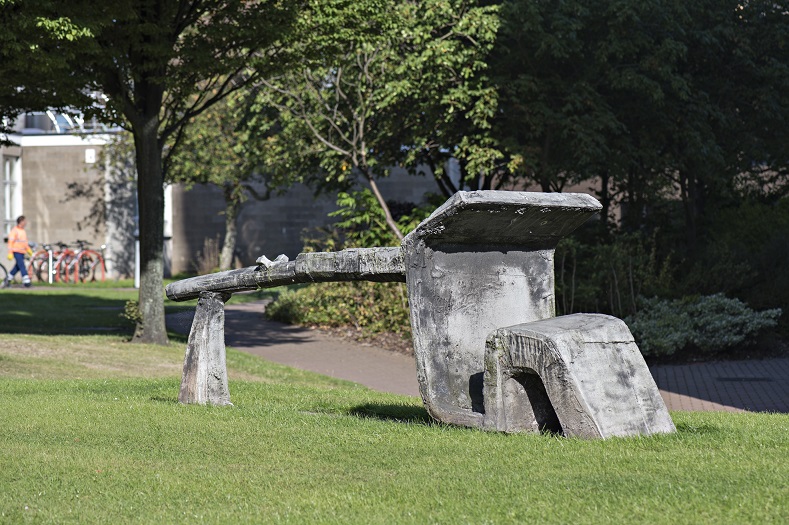
Location (google maps)
This is one of three sculptures produced by Geoffrey Clarke for the then annual Battersea Park open air sculpture exhibition in 1963 (another is in the collection of Pangolin Gallery in London). Recalling a plough, and with a hint of violence, it was cast in aluminium from an expanded polystyrene model: a highly experimental method, which allowed for work to be produced quickly and cheaply whilst giving it a rough-hewn, organic appearance.
Along with Lynn Chadwick, Clarke was one of eight sculptors who showed work at the Venice Biennale's British Pavilion in 1952 (others included Eduardo Paolozzi and William Turnbull). In a review of the Pavillion, Herbert Read described their work as creating a 'geometry of fear' and for a short period the group were considered the cutting-edge of contemporary British sculpture. Clarke produced work for a variety of contexts: a large, aggressive aluminium wall-mounted work for Nottingham's Playhouse Theatre (which survives to this day), relief panels for the ocean liner SS Canberra, fittings for banks, a tapestry for a Kuwaiti sheikh, works for two Cambridge colleges, and the altar and three stained glass windows for Coventry Cathedral. Yet as the 'geometry of fear' went out of fashion Clarke fell from the public eye, and the Battersea Park Series, of which this is one, were among the last of his sculptural works to receive significant attention. The Guardian obituary on his death in 2014 notes that they have 'a rough-hewn, bark-like quality that gives them the look of a medieval take on Anthony Caro's contemporaneous Early One Morning', but that this 'did not serve Clarke well' in an era of pop art slickness. History has been a little kinder, however, and there was renewed interest in his work by the 2010s.
Gerald Gladstone - Venus Probe II
Welded steel, 1963
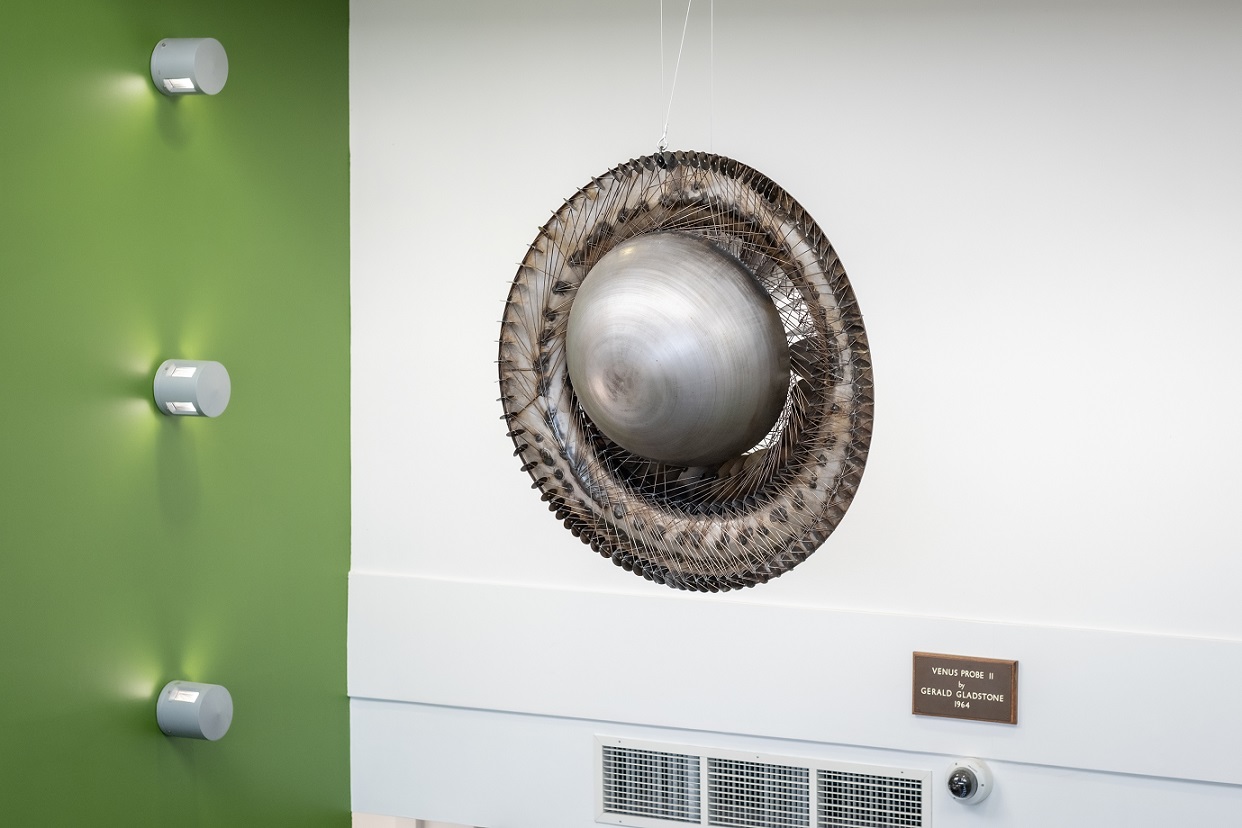 Location (google maps)
Location (google maps)
In both name and form Gerald Gladstone’s Venus Probe II shows the clear influence of space exploration. It is likely named for the American probe Mariner 2 which, in 1962, conducted the first successful planetary encounter when it returned data about Venus having flown close to the planet.
In this, the sculpture can be seen as expressing a modernist optimism: it aestheticizes the technology which many believed would help expand human power and knowledge, and many decades later its form remains suggestive of a daring hope to know. Yet this is not all it represents: the space race, at its height in the 1960s, was also a military race in which the USA and USSR sought to develop their military power and so the sculpture also carries with it the legacy of the Cold War; a more anxious modernism that can also be seen in Lynn Chadwick’s sculpture The Watchers, between EHB and Herbert Manzoni.
Gerald Gladstone was a Canadian sculptor. In 1959 he moved to London where he was mentored by the famous British sculptor Henry Moore. By the mid 1960s he had returned to Canada, where he received three commissions for Montreal’s Expo ‘67, including Uki, a fire-breathing ‘monster’ sculpture half-submerged in a lake. Later works included a fountain sculpture for Montreal’s Place Ville Marie; the Martin Luther King Jr. Memorial in Compton, California; Universal Man, for a plot beneath Toronto’s CN Tower (then the world’s tallest building); and Galaxy, for government buildings in Canberra, Australia. Gladstone died in 2005.
Venus Probe is one of many artworks in the University’s collection commissioned or purchased under the auspices of Stewart Mason, who was Leicestershire's Director of Education from 1947-71. He strongly believed that educational environments should be populated with challenging works of contemporary art, and worked with a team of advisors and contemporary art galleries to select works. It was purchased in 1964 for the then-new Herbert Manzoni Building, built as the library for Loughborough College of Technology. In 1967 it was shown at the Whitechapel Gallery as part of an exhibition of works from the Leicestershire Education collection.
Anne-Marie Culhane - Fruit Routes
Fruit trees and edible plants (2011-)
 Picture: 'Cropweave', Spring Harvest 2019, Anne-Marie Culhane., Loughborough University
Picture: 'Cropweave', Spring Harvest 2019, Anne-Marie Culhane., Loughborough University
Click here for trail (google maps)
Fruit Routes is a work of eco-social sculpture by the artist Anne-Marie Culhane. Combining art, the everyday and ecological landscaping, it consists of an edible route of hundreds of fruit and nut trees and bushes, including six discrete clusters of trees. Fruits grown include cooking, eating and cider apples; pears; cherries; apricots; greengage; plums; almonds; walnuts; sweet chestnuts; mulberries and quince. Contributing to the campus environment, improving conditions for wildlife and enabling the foraging of free food, the work is intended to spark conversations about the politics, economics and ecologies of food production, distribution and consumption. Two event programmes are organised annually to mark the season, including a ‘harvest festival’ with a mixture of performances, walks, talks, workshops, harvesting and fruit pressing. More information can be found on the project's dedicated website.
Georgie Gerrard - Six Locations: Durdle Door
Fired eucalpytus paper shreddings, wheat bran, barley straw, stoneware clay, reishi mushroom (Ganoderma multipileum), and oat seed spawn
Edward Sharp Prize Winner, 2022
.jpg)
Location (google maps)
NB: This sculpture can only be viewed during the Edward Herbert Building's standard opening times (8.30-6pm Mon-Fri).
This remarkable sculpture was an Edward Sharp Prize Winner in 2022. It's one in a series of eleven works that combine Textiles graduate Georgie Gerrard’s interest in biomaterials with a personal interrogation of location, geology and family history. It’s bound together by mycelium, the root structure of fungi, a material with a wide range of potential applications in fields as diverse as construction, fashion, furniture, agriculture and pollution remediation. Gerrard is inspired by the potential environmental benefits of these applications, but is also fascinated by its aesthetic properties. Indeed, Six Locations: Durdle Door shows a real fidelity to mycelium’s visual and tactile character, down to the emergence of the mushrooms themselves from the top of the sculpture.
The sculpture’s form is inspired by Durdle Door, a natural limestone arch on the Dorset Coast. Gerrard’s grandfather was a geologist who frequented the area on field trips, and the substrate through which the mycelium has grown includes organic materials local to the location. The other sculptures in the series relate to further locations of importance for Gerrard’s family, and she conceives of the works as a ‘unified body of artefacts connected by the mycelium that permeates them.’
Making work from such organic materials is, of course, a highly experimental process. Working with a living material that responds to temperature, light, moisture and sterility levels means that, for Gerrard, ‘the aesthetic outcome was ultimately something I had little control over, allowing the materials to speak for themselves.’ The work’s colour derives in part from its materials, but has also been informed by the conditions in which the mycelium was grown and the sculpture was cured.
Gerrard graduated with a BA in Multimedia Textiles in 2022 and is hoping to continue her work at the intersections of art, biodesign, circular design, sustainability, and material innovation.
Michael Gillespie - Double Movement
Bronze, 1993
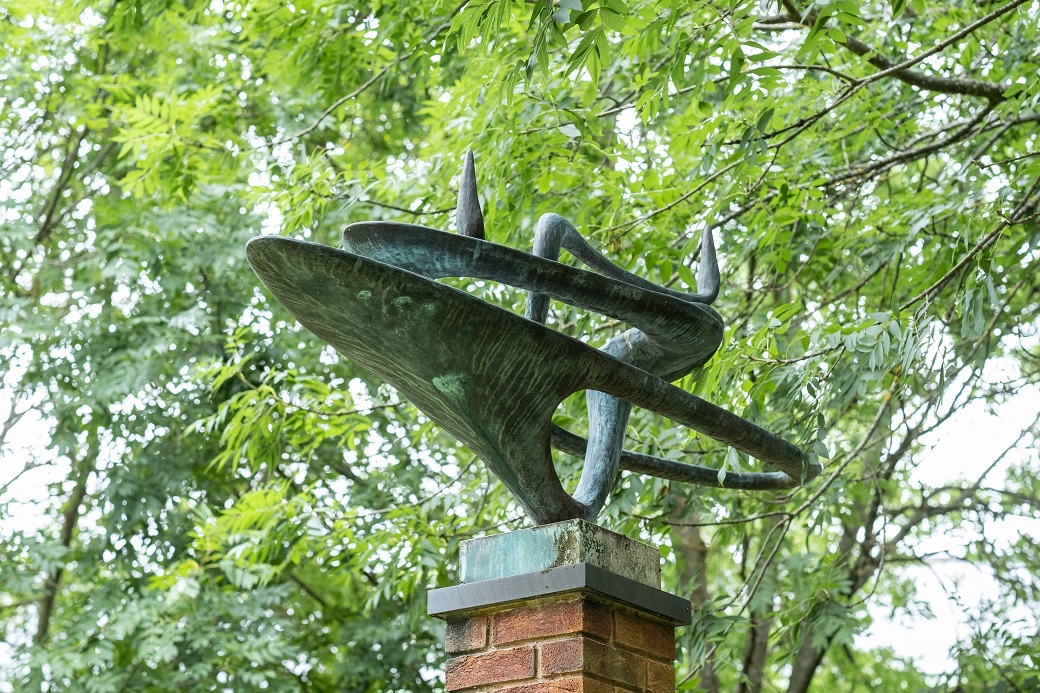
Location (google maps)
Double Movement was commissioned by Leonard Manasseh, the architect responsible for British Gas' Research and Technology Centre, after he saw an early version in a 1993 exhibition at Churchill College, University of Cambridge. When British Gas departed the site, the sculpture and buildings became part of the University's estate.
Michael Gillespie was a well-known sculptor who had periods working for Jacob Epstein and Elisabeth Frink. His own works are highly suggestive of motion though he cautioned against reading specific meanings into them, urging viewers to engage with them as if they were listening to music.
Bryan Kneale - Standing Figure
Painted steel, dustbin lid, 1961
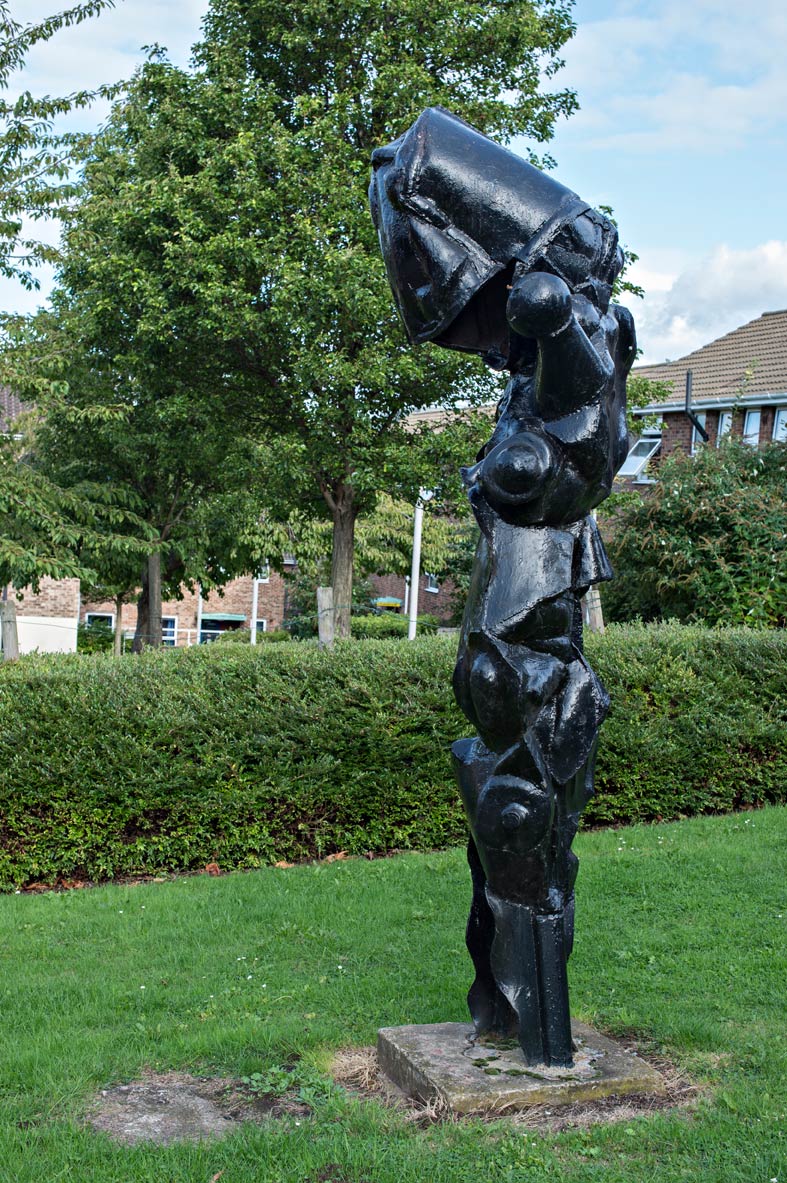
Location (google maps)
This remarkable sculpture has been bringing a dose of sci-fi otherness to the Student Village since its construction in the early sixties. It soon acquired the nickname ‘Fred’ and acquired sainthood at some point, with students of nearby Royce Hall throwing an annual ‘St. Fred’s Day’ party at the end of each academic year.
The figure’s distorted form is suggestive of the folklore and horror infused science-fiction so popular when it was made. Indeed, Kneale’s brother Nigel was the screenwriter of the BBC’s Quatermass serials, one of the most popular expressions of this kind. Bryan Kneale also illustrated the cover for the Penguin paperback editions of the scripts, whilst the Martians in Quatermass and the Pit were based on a painting he’d done of a lobster. His artistic output is more varied than this might suggest, however: across a long career in sculpture and painting he displayed an ‘innate fear of repetition’ and a rejection of the ‘traditional sculpture of carving, casting and modelling’, as the catalogue for Pangolin London’s 2015 retrospective put it. Born on the Isle of Man, his sculptural interpretation of the island’s three-legged symbol, Three Legs of Man, stands outside its airport.
The painted finish currently sported by this work is not in keeping with its original condition, and so it is to be stripped back to the metal, cleaned of rust, and restored to match its original condition.
Atta Kwami - Atsiaƒu ƒe agbo nu
Painted marine plywood; 2020 (installed 2022)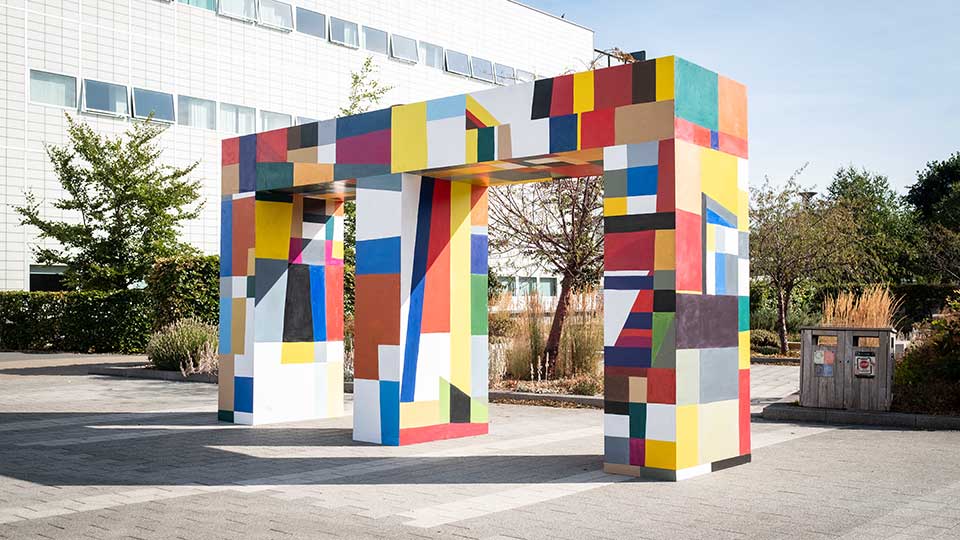
Location (google maps)
Atsiaƒu ƒe agbo nu (Gateway to the sea) is among the last works produced by the Ghanian artist Atta Kwami, who made Loughborough his home with his wife Pamela Clarkson Kwami for many years. It was commissioned for a plot at the beginning of Folkestone Harbour Arm for Folkestone Triennial in 2021 and is named in the Ewe language, spoken mainly in West Africa. Its striking double archway is designed to provoke reflection on immigration and emigration: a joyous riposte to the architectures of control usually found at borders. Relocated here, close to a major pedestrian entrance to campus, it marks a transition from town to campus (and vice versa).
The work gives sculptural form to Kwami’s interest in vernacular structural, material and decorative forms, and is inspired by his desire to ‘transform ordinary objects into magnificence’. This approach is explored in his 2011 book Kumasi Realism 1951-2007: An African Modernism, which rejects the dichotomous treatment of African culture as rooted in ‘tradition’ against a (supposedly) Euro-American ‘modernity’, and brings everyday forms of visual culture such as sign-painting into conversation with contemporary art.
Kwami was born in Accra, Ghana, in 1956, and across four decades produced a large body of paintings, sculptures, prints and publications. He received a PhD from the Open University in 2007, and taught in Nigeria and Ghana. After meeting the artist Pamela Clarkson in the early nineties he divided his time between Ghana’s second city Kumasi and Loughborough, where he latterly held a studio at Modern Painters, New Decorators. His work has been shown at galleries around the world, and can be found in the collections of the National Museum of Ghana, the V&A, the Smithsonian National Museum of African Art in Washington D.C., The National Museum of Kenya, New York’s Metropolitan Museum of Art, and the British Museum. Shortly before his death in 2021 he designed stained glass windows for the National Cathedral of Ghana, and was awarded the prestigious Maria Lassnig Prize, resulting in a new public mural and monograph in association with London’s Serpentine Gallery.
We are grateful to Pamela Clarkson Kwami and Andy Philpott for facilitating the loan of this work.
Neil and Auriol Lawson Baker - The Flame
Bronze; 1993
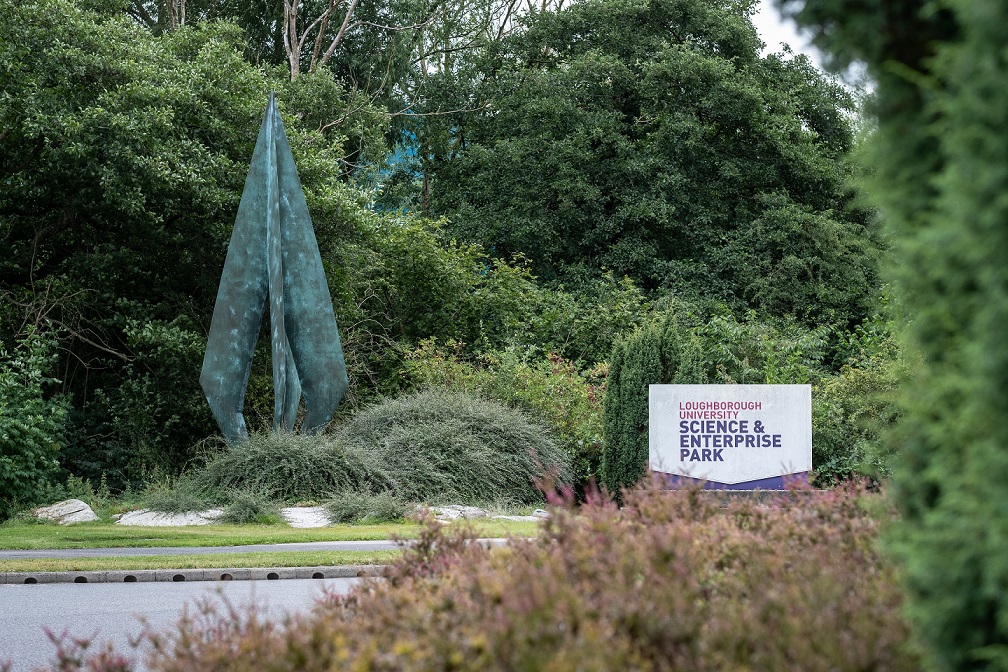
Location (google maps)
This 6.7m high bronze work was commissioned by British Gas during a period when its research arm was based at what is now Loughborough University’s Science and Enterprise Park. Clearly resembling the flame of a gas boiler (and the then British Gas logo), its five sections represent the five continents. It is one of two casts: the other is situated outside British Gas’ headquarters at Thames Valley Park in Reading. The Flame originally flickered at night, but the complex lighting system has been damaged beyond repair.
The work was produced by the then husband-and-wife partnership of Neil and Auriol Lawson Baker. Little is known about Auriol, but Neil’s artistic career neatly illustrates the shift away from a social democratic model of public art (exemplified on campus by Stewart Mason's approach) to a more neoliberal approach. A dental surgeon-turned-artist, he was very much in vogue with newly-privatized and financial industries during the early 90s: as well as British Gas he designed a sculpted version of BT’s then new ‘piper’ logo in 1994 (although only a 24cm high desk version was ever produced); a statue of a trader for the London International Financial Futures and Options Exchange; and an abstract work for Eurotunnel.
Robert Orchardson - We Are the Sky
Steel, brass, mirrored glass; 2015
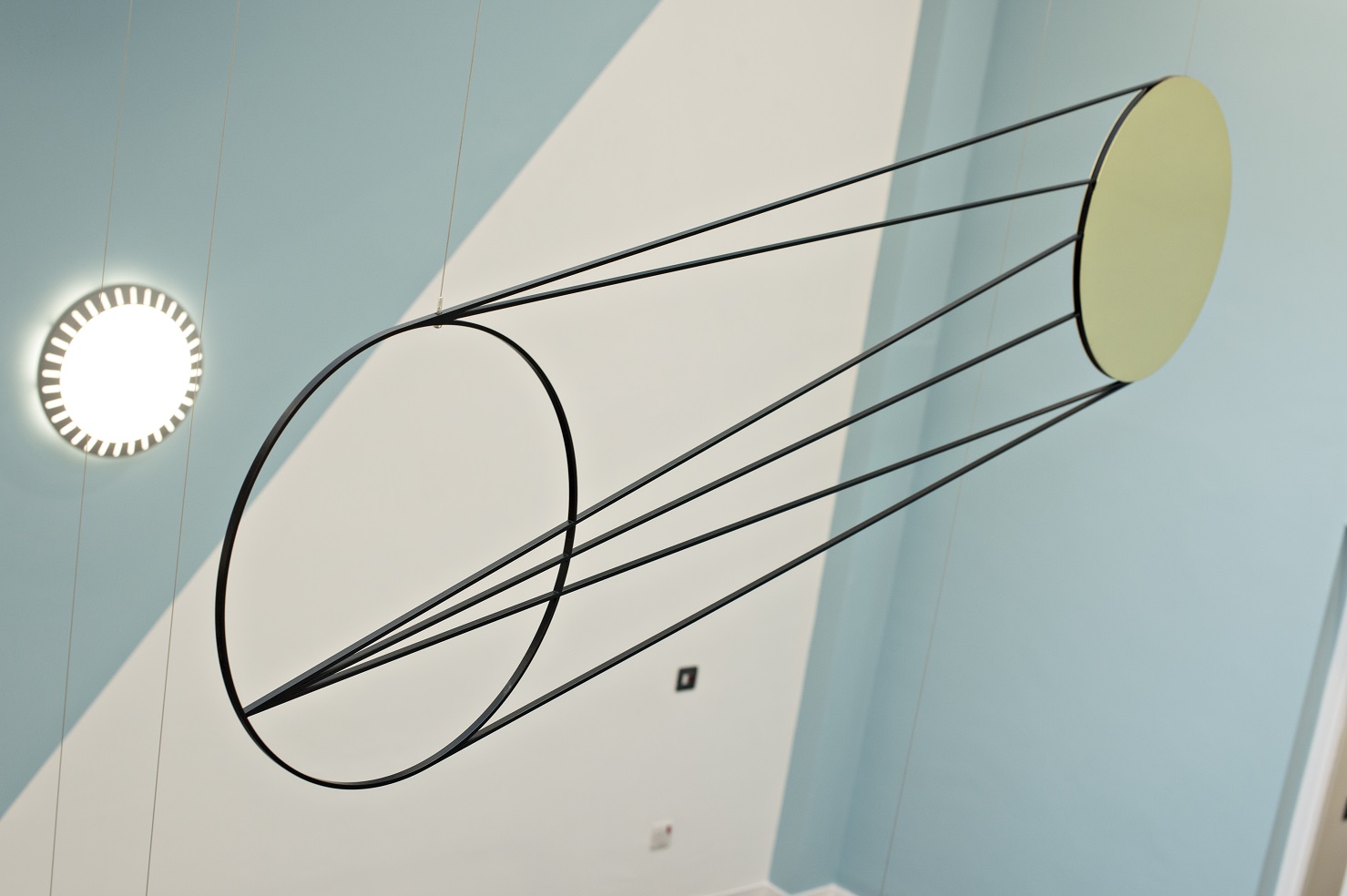
Location (google maps)
We Are the Sky was the winning entrant in a public competition to design an artwork for the atrium of the refurbished Schofield Building in 2015. Inspired by images of early aviators and scientists, it draws on the pioneering structures of early kites. Each element of the work is suspended in air, and it can be viewed from different angles as the stairs are ascended or descended.
Orchardson draws on the imagery of science-fiction and utopian modernism in his work, which is often constructed from lo-tech materials such as wood and resin. He has held solo exhibitions at NOW Gallery, London; Ikon, Birmingham; and Monitor Gallery, Rome.
George Pickard - Triptych
Stainless steel, 1988
.jpg)
Location: Pearce Committee Room, Hazelrigg Building (Viewable by appointment only. Please email LUArts@lboro.ac.uk to request.)
This modernist relief was donated to the University by Herald and Joan Goddard in memory of Professor J.G. Phillips, Loughborough's fourth Vice-Chancellor, who died just a year into his office in 1987. Professor Phillips was a noted biologist, and also served as Secretary of the Zoological Society of London.
George Pickard trained at Leicester School of Architecture in the early 1950s, then served in the army as a Regimental Artist, producing murals, magazine illustrations and camouflauge designs. From 1957 he practised architecture and developed skills in ceramics and metalwork. From 1966-88 he was a senior lecturer in interior design at Leicester Polytechnic, during which time he took to producing sculpture and founded the Architectural Sculptors Group. He produced a number of sculptural works, including another piece similar to this which was featured in a 2018 episode of Antiques Roadshow.
Herald and Joan Goddard were longstanding patrons of the arts, primarily in their home city of Leicester.
Bernard Schottlander - Abstract
Steel, 1971
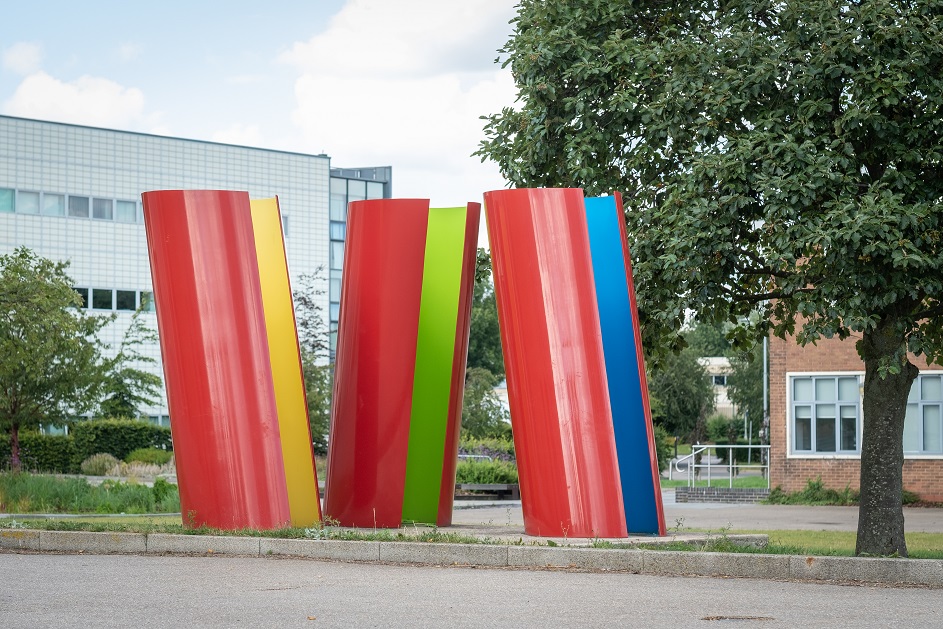
Location (google maps)
One of two sculptures installed at Loughborough in the final year of Stuart Mason's tenure as Leicestershire's Director of Education, Schottlander's steel Abstract was purchased for Loughborough College of Education for £375 (the College of Education shared the campus with the University, but was not formally integrated until 1978). The following year Mason was one of two people who selected sculptors for the ambitious 'City Sculpture Projects', which saw large-scale contemporary sculptures installed in 14 cities across the UK including, famously (and controversially) a giant King Kong in Birmingham.
Abstract is typical of Schottlander's work: the cylinders appear solid if approached from one angle, but open up to reveal differing internal colours when the viewer moves around the work. Born in Mainz in 1924, the Jewish Schottlander arrived in Britain as a refugee from Nazi Germany in 1939. He worked as a welder during the war, before training in Sculpture at Leeds College of Art. He combined his sculptural works with works of interior design, most notably the 'Mantis lamp'. Mystery surrounds the installation of another Schottlander work on campus: an edition of 3B Series No.2 was in-situ at the foot of Towers in the mid 80s, but there is no record of it before or since. It is believed this may have been the casting bought by Leicestershire for Bosworth School in Desford near Leicester.
Will Shannon - Public Workbench
Stained timber, 2021
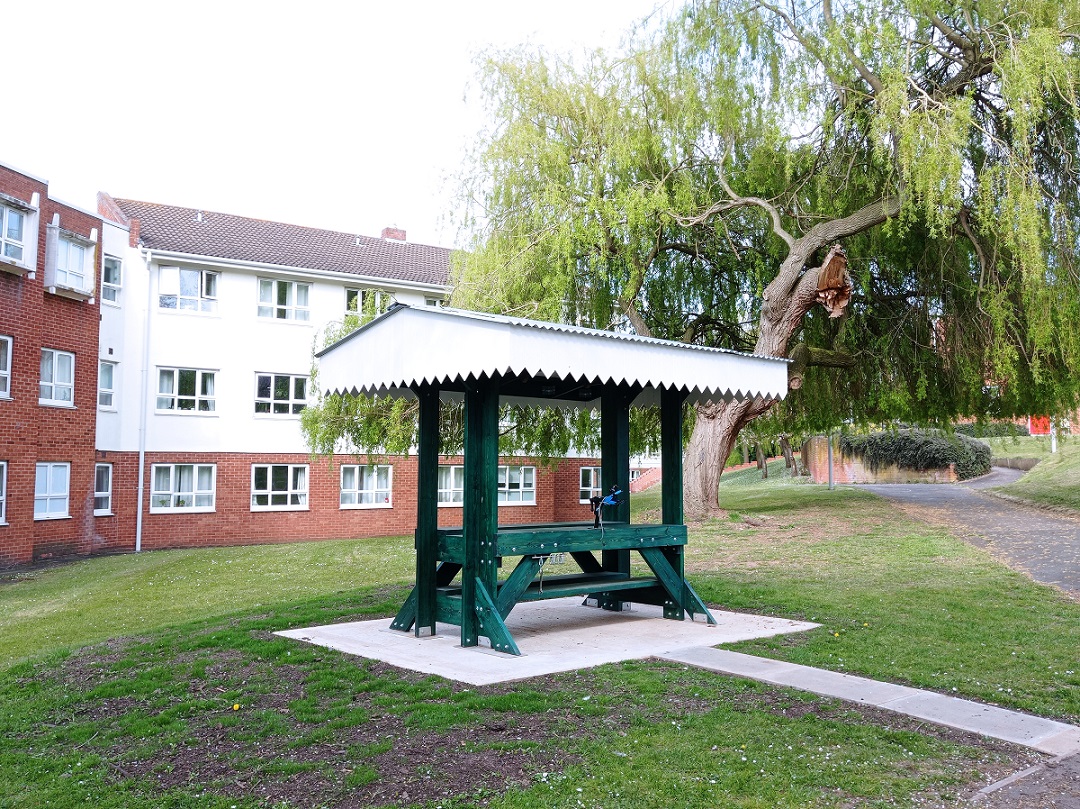
Location (google maps)
Will Shannon was LU Arts' Handicrafts Artist-in-Residence 2020/21. Taking inspiration from the history of the University's Handicraft Unit, he proposed a functional sculpture that can be used for practical purposes by members of the University community. Following consultations on form and function with students, Shannon developed Public Workbench. Inspired by the forms and methods used in the Handicraft Unit, as well as the cantilevered canopies of Loughborough's Great Central Railway station, the work sits in a central location on campus and is regularly brought to life by informal or organised events and activities.
Willi Soukop - Spirit of Adventure
Concrete, 1958
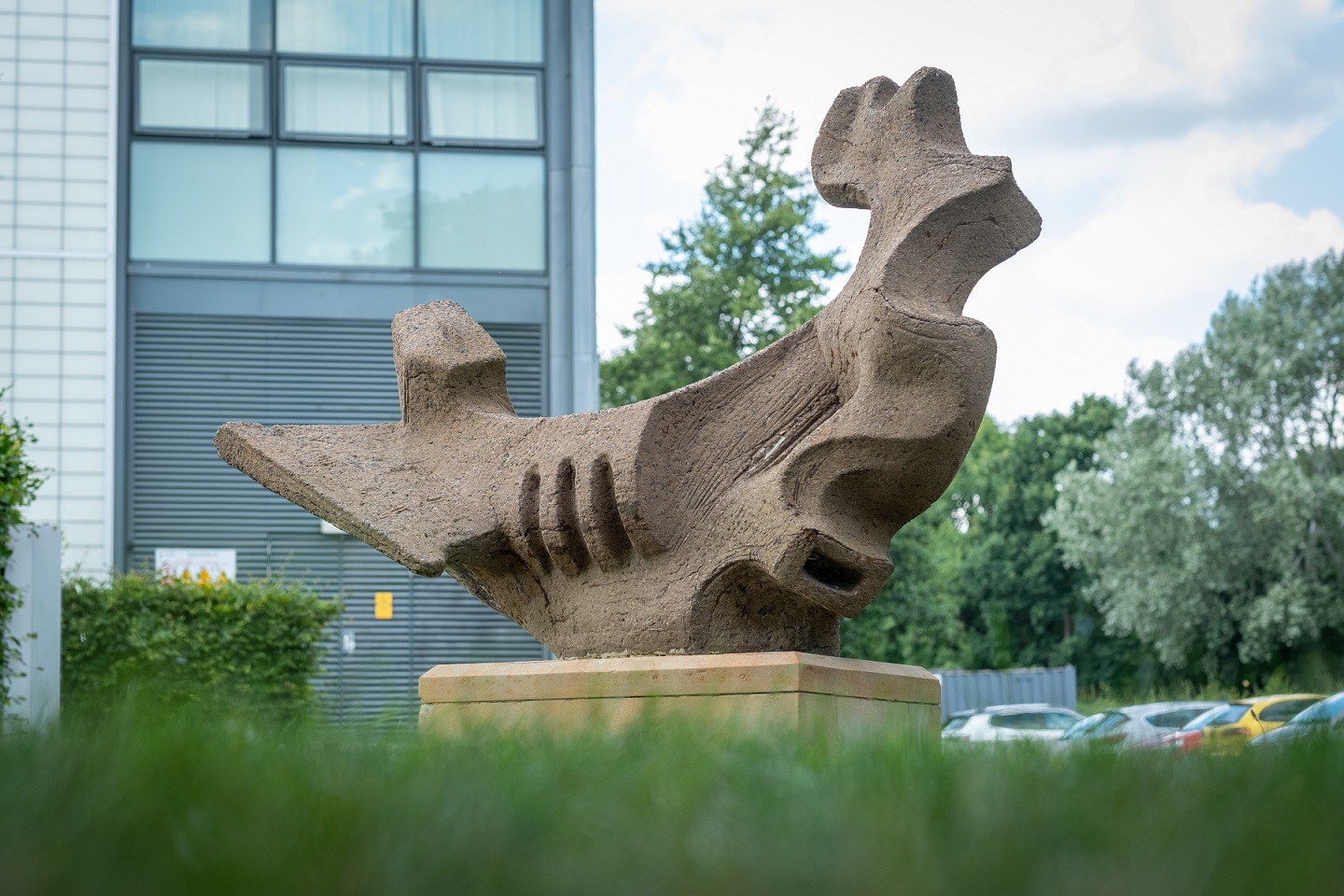
Location (google maps)
Dating from 1958, this concrete work is one of the first purchased for Loughborough during Stewart Mason's tenure as Leicestershire's Director of Education. A semi-abstract piece, it brings to mind an aeroplane when viewed from some angles, whilst others are more suggestive of an organic form. On viewing it in 2011 the artist and poet Wayne Burrows ascribed it 'the presence of an artifact from a lost civilisation, part of a modest civic vision of the future whose potential has passed (perhaps only temporarily?) into a history that appears more remote than it actually is.' Prior to being installed in Loughborough it was exhibited at the Royal Academy of the Arts.
Willi Soukop was born in Austria and trained at the Academy of Fine Arts in Vienna. He moved to England in 1934 for romantic reasons, taking up a studio and teaching post at Dartington College in Devon before moving on to Chelsea College of the Arts, the Royal Academy and the British School in Rome. Among his pupils was Elisabeth Frink, who would go on to be recognised as one of the country's most important sculptors. A number of his works were purchased or commissioned for educational establishments across Leicestershire, though many have been lost.
Willi Soukop - Relief of a House Martin
Concrete, 1958
.jpg)
Location (google maps)
Stewart Mason ensured that a small portion of Building Capital Funds was put aside for artworks whenever new buildings were commissioned. A modest example is this pleasant relief of a house martin on Martin Hall: a very different style to The Spirit of Adventure. This was most likely installed during the building of Martin Hall in 1961.
The hall itself is not named for the bird shown, but for Sir Robert Martin (1874-1961). He was appointed a Governor of Loughborough College (a predecessor institution to the University) in 1922 and in 1924 Chairman of Leicestershire County Council and its Education Committee. He became Chairman of the Governors of Loughborough College in 1940 and of its successor Loughborough College of Education until his retirement in 1961.
Another Soukop relief can be found on the Brockington Building. It has three separate components showing students running and swimming; debating and studying; and undertaking wood- and metalwork.
Studio Weave - Bathaus
Reduced cottage, 2017
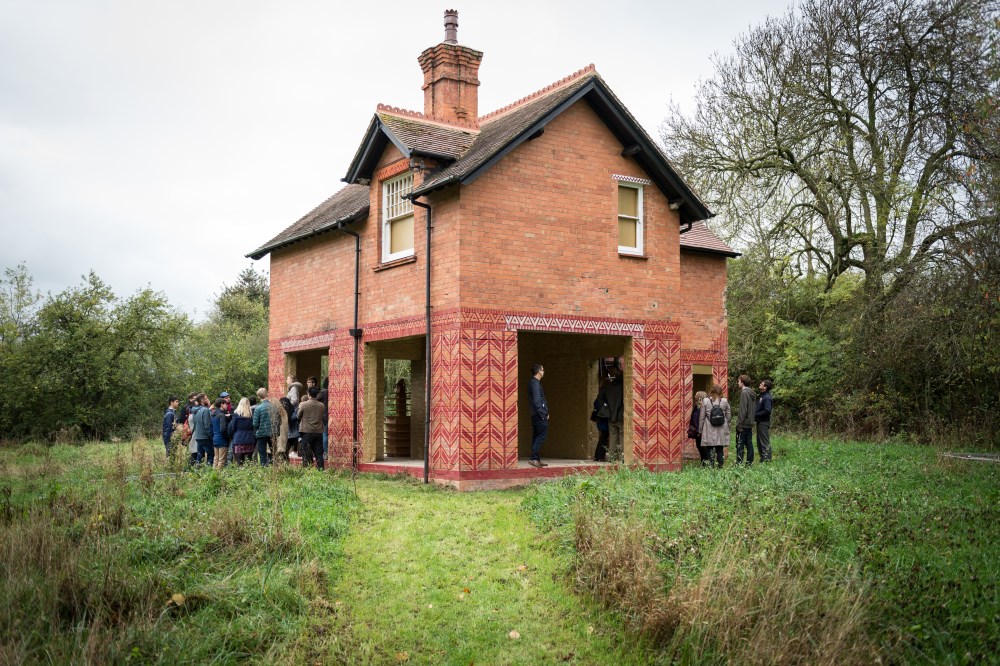
Location (google maps)*
Realised in 2017, Bathaus is a ‘curated reduction’ of an old cottage within campus grounds. Abandoned by humans, the building was discovered to play home to a summer maternity colony of brown long-eared bats. Architectural practice Studio Weave’s subtly powerful design evokes both this current use and the traces of previous human habitation.
*To access the Bathaus head along Oakwood Drive and go past the Advanced Technology Innovation Centre on the right. You’ll come to a track on the left, just wide enough for a car. Walk along here and the Bathaus is on the right. The ground is flat but a little bumpy, and may be muddy in wet weather.
David Tarver - Entrance Relief
Aluminium, 1968
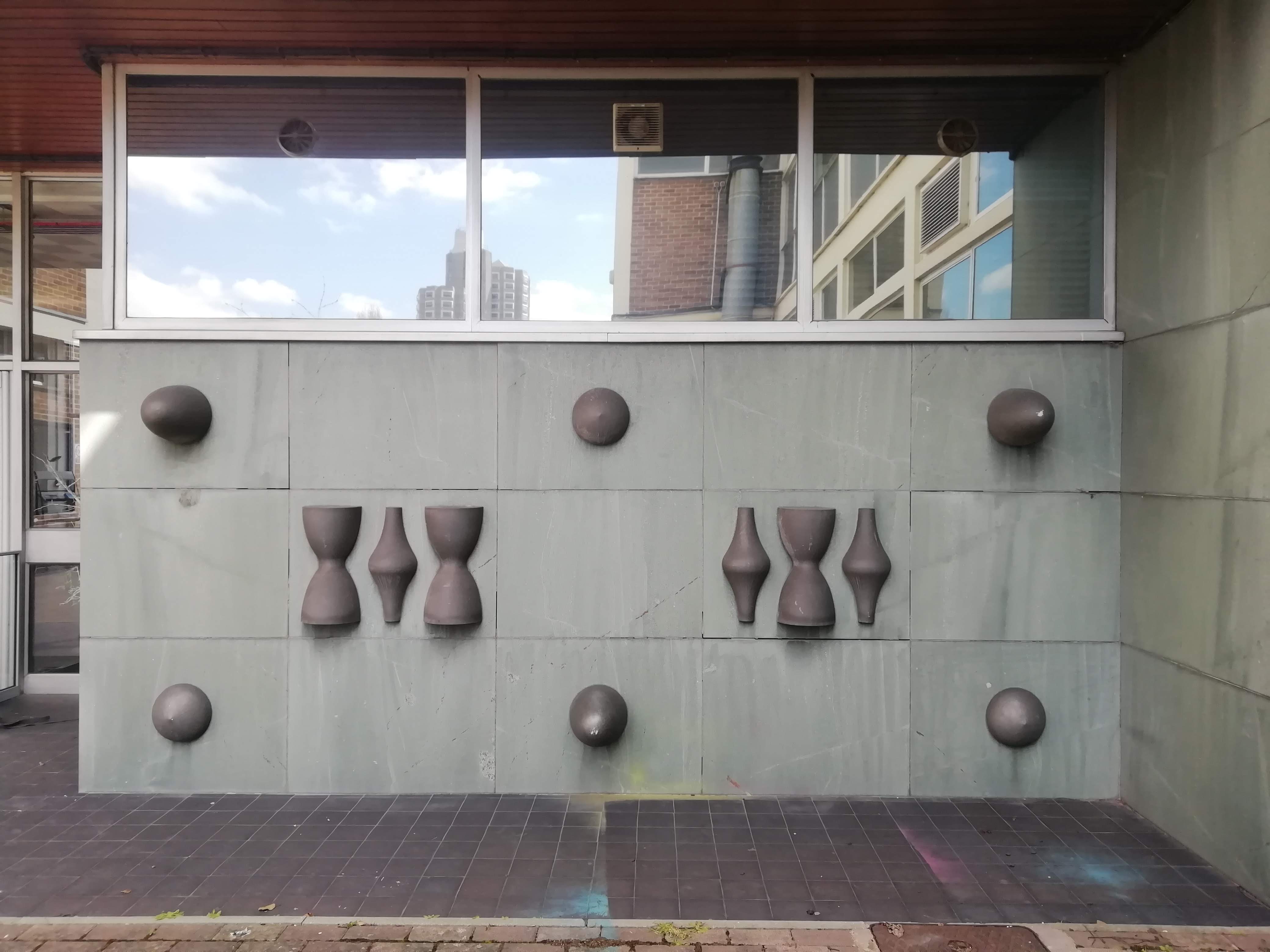
Location (google maps)
Margaret Traherne - Standing Stones
Concrete, c.1959
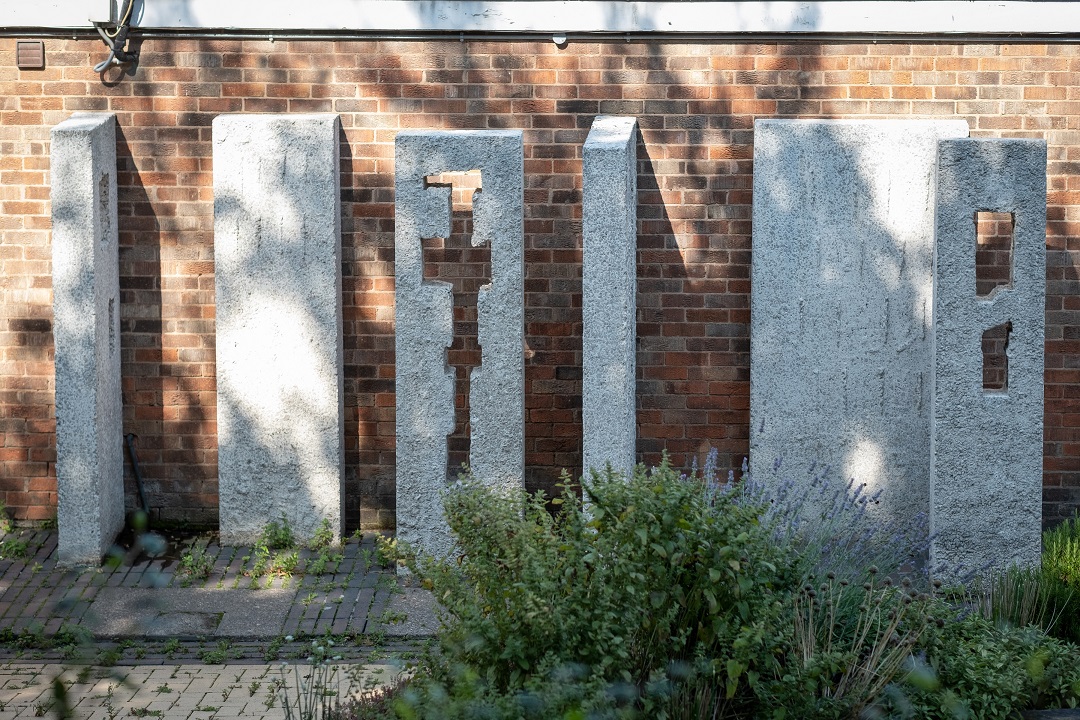
Ian Tricker - Aftermath
Stainless Steel, 2014
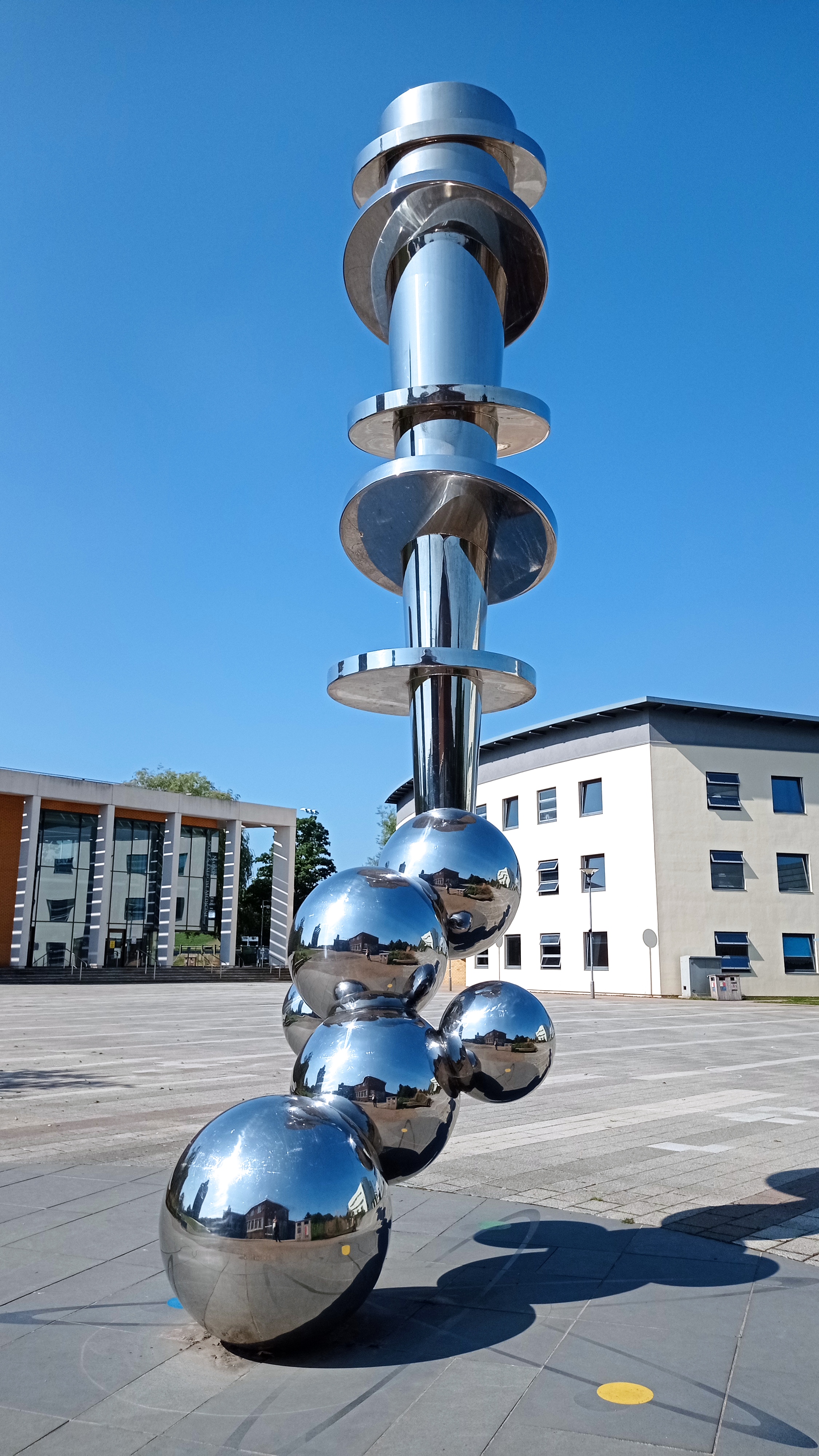
Location (google maps)
Fine Art student Ian Tricker won a student competition to design an artwork for the then-new Shirley Pearce Square in 2014. The work's abstract form is a playful riff on the research and equipment of the nearby National Centre for Sport and Exercise Medicine, whilst its reflective surface is intended to inspire introspection. During Graduation ceremonies the work turns into a fountain with water cascading over its form, suggestive of a new beginning for graduates.
Tricker developed his sculptural skills whilst studying Fine Art at Loughborough from 2011-2014, and subsequently studied for a Masters in Sculpture at the RCA.
Ian Tricker - Torque
Stainless and corten steel, 2022
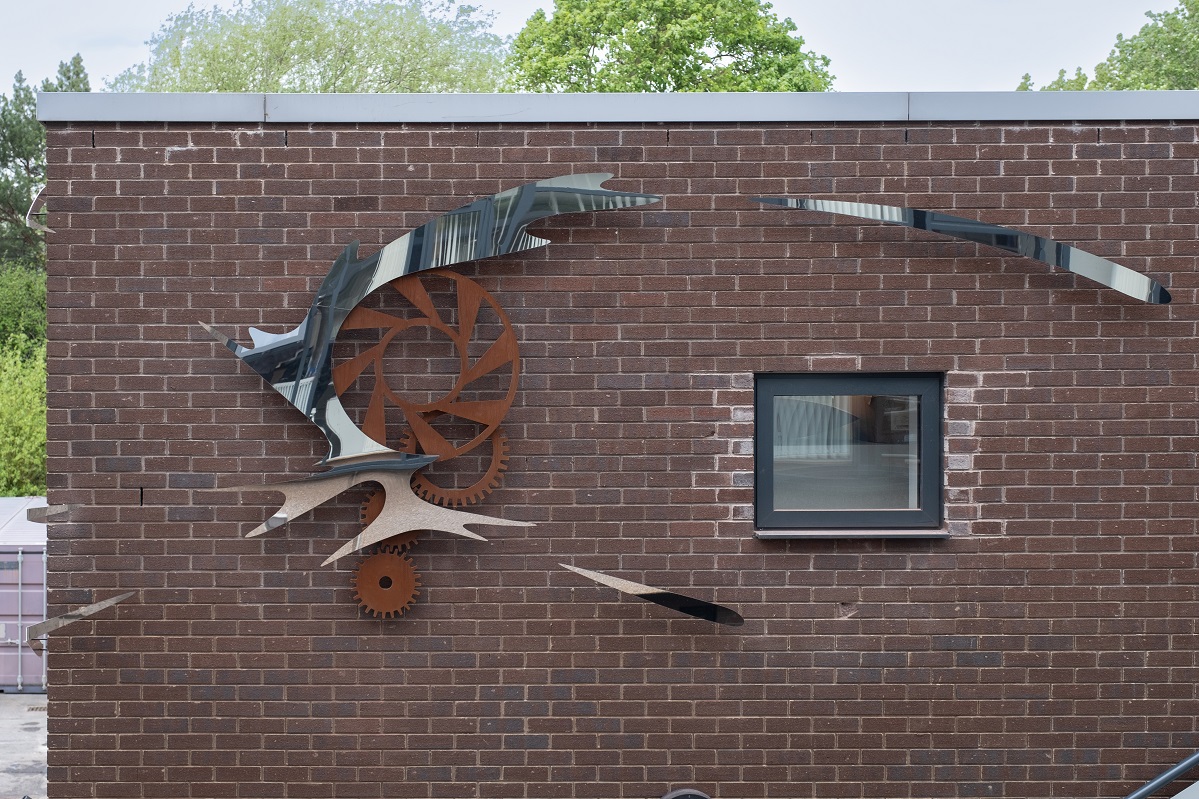
Location (google maps)
With stainless steel elements flung across and around the upper corner of the Eccleston Student Engineering Centre, Torque invokes the dynamism and power of the activities that take place within the building. Its highly polished surfaces change with the light, and the sense that you can never quite see the same work twice is furthered by its refusal to privilege a single viewing point: try looking up at it from the ground, side-on from the landing at the top of the external stairs, or as you ascend or descend one of the S Building’s rear stairways.
The Eccleston Student Engineering Centre provides students with a purpose-built space for the pursuit of extra-curricular automotive and aeronautical engineering projects, and was funded by Barry and Valerie Eccleston. Following its opening in 2019, they made a further donation for the commissioning of a new sculptural work for its exterior wall. The commissioning process took the form of a competition open to current and recent Loughborough University students, with the judging panel including representatives of student societies that use the building.
In addition to Torque and Aftermath, Tricker's The Sound of Time can be found is in Loughborough’s Queen’s Park.
Paul Wager - Five Steel Sculptures
Steel, 1993-96
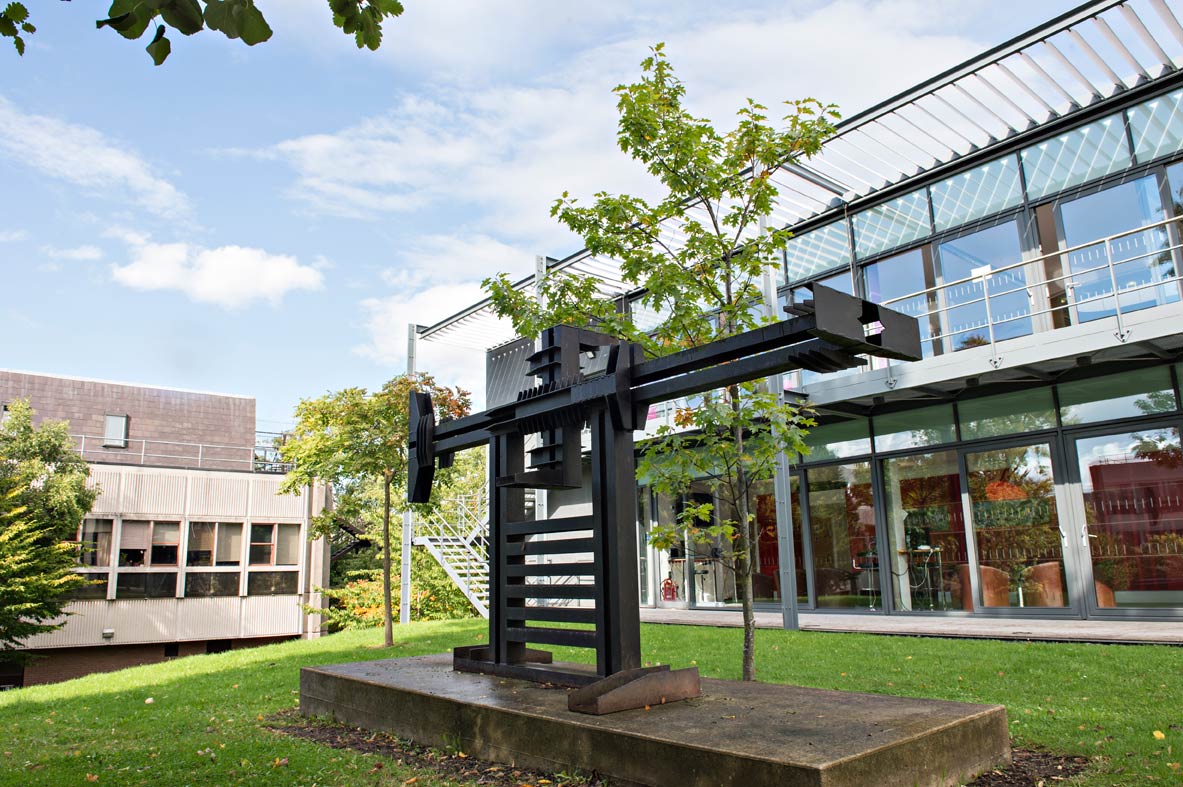
Wager was born in Hartlepool in 1949 and served as an assistant to Lynn Chadwick for a number of years. After spells teaching at institutions including the Winchester School of Art and the Central School of Art & Design in London, he took a teaching job at Loughborough College of Art and Design, where he remained until the early years of the twenty-first century. He continued to produce sculptural and painted works tackling war, authority and decentralized economies until his death in 2020.
Austin Wright - Fountain
Aluminium, 1971
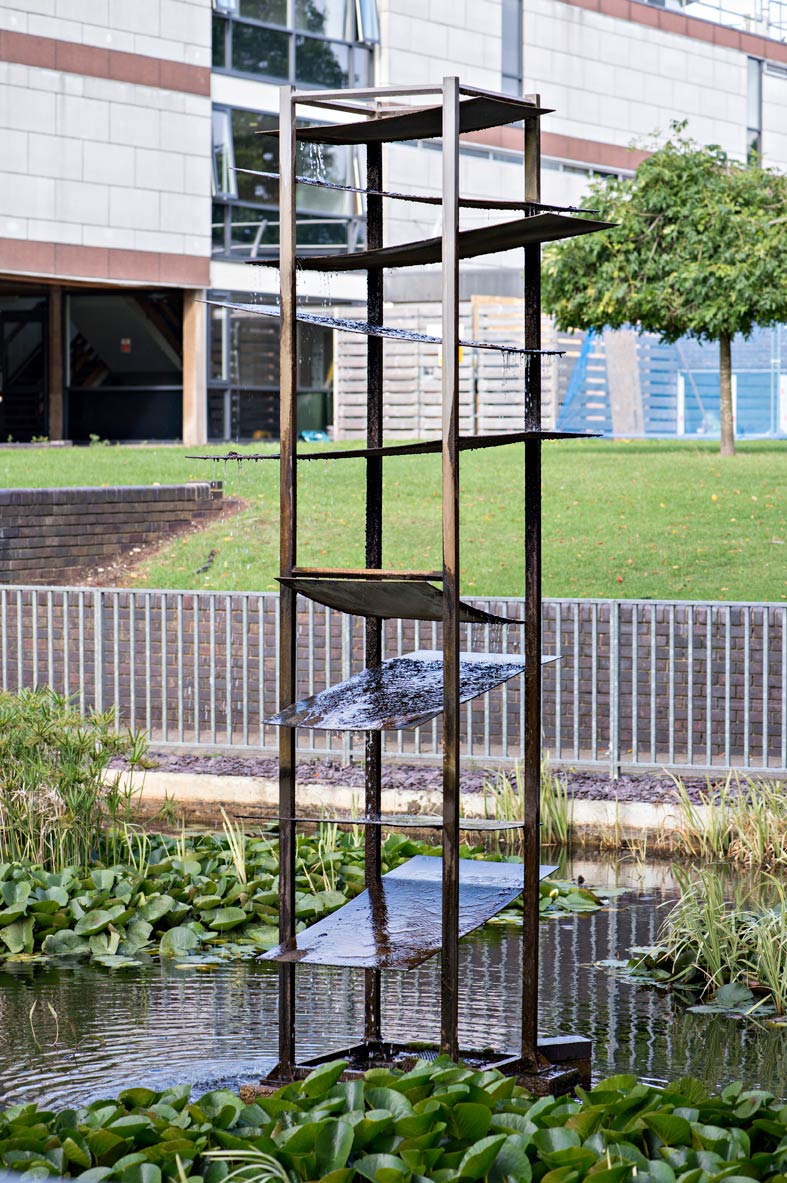
Wright was highly regarded during his lifetime: he exhibited across the world alongside contemporaries including Eduardo Paolozzi, Elisabeth Frink, Lynn Chadwick and Geoffrey Clarke. In 1955 the Guardian art critic Charles Sewter stated that 'it would not be outrageous to claim that Wright is the most gifted sculptor working in Britain today', and two years later he won the acquisition prize at the São Paulo Biennial. He began working in aluminium in the early 60s, associating it with light and air, and finding it a release from the 'earthbound' lead and concrete in which he had often previously worked. 'It projects its lightness...speak[ing] out to any form of light in the sky. Come out into the garden and it chirps in a startling way.'
By this time Wright was increasingly influenced by the landscape of his adopted home of Yorkshire, and it was his perhaps his preference for the region over London that lead to his relative neglection by the contemporary art world; though unsurprisingly he has work in the collection of the Yorkshire Sculpture Park. In an obituary upon his death in 1997, The Independent wrote that 'discovering Wright [is] like discovering evidence of a whole new school of art developing in parallel with the known world, a new country on a new morning.'
